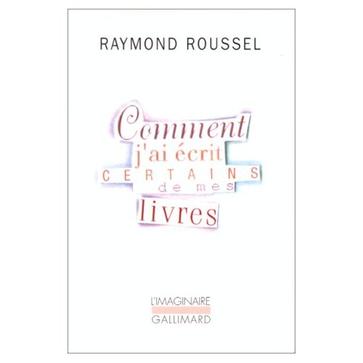Raymond Roussel (1877–1933): Part 2 — The work 'explained'

Serious interest in Roussel began with the posthumous publication of a short essay entitled, How I came to write certain of my books (Comment j'ai écrit certains de mes livres), composed just before his suicide in 1933. Though the paper purports to give a "key" that will enable readers to understand the connections between the apparently arbitrary scenes in Impressions of Africa and Locus Solus, Impressions already supplies its own explanation. The novel is divided into two main sections–chapters 1-9, and 10-25–with a forward advising readers to skip the first section wholesale and begin at chapter 10. However, most readers refuse the provocation and begin at the beginning, though they are soon just as lost as if they had started in the middle.
On the main square of a purely imaginary African capital, a series of acts, in the theatrical sense, are performed, each more unbelievable than the rest: a marksman manages, by shooting at it, to separate the white from the yolk of a soft-boiled egg; six brothers, because of their extreme thinness and the hollowness of their chests, reflect, by placing themselves at regular intervals, the voice of their father exactly like the echo in the nave of a cathedral; a singer has a mouth and tongue so shaped that he is able to sing, at the same time, four tunes, or the four parts of a canon.
Many of these impossible acts involve equally impossible machines. The statue of a Lacedonian slave (a helot) is made of corset stays. It is set on a base supported by wheels, themselves placed on rails made of a pinkish substance, which turns out to be the lights that cats are fed on. A magpie has been taught to operate with its beak a complex mechanism which tilts the statue, back and forth, on its base.
In the first nine chapters dozens of such wonders are presented, one after the other, without the least explanation, to an astonished reader. The next fifteen chapters provide an explanation, by placing them in a narrative framework: the dynastic quarrels in two African kingdoms, a steamer on its way to America stranded on the African coast, an order imposed on some of the white captives by a rather capricious black sovereign, the desire of the rest of the white people to impress him by showing their best tricks.* A host of stories provide a "logical" explanation for each act.
... First we have a tableau vivant, then a fiction which "explains" it, (Philosophy through the Looking Glass, Jean-Jacques Lecercle, p. 18).
This is how the linguist Jean-Jacques Lecercle describes a first pass of Roussel's novel, pointing out what's often elided, that the book gives its own explanation, "if explanation is the right word, so contorted, gratuitous and absurd is the fiction, (ibid.).
"Jean-Jacques Lecercle is Professor of English at the University of Nanterre, France, and a worldwide authority on Nonsense,” (ibid, back cover). He is also a serious scholar of fou littéraire, and his writings on this subject are the best introductory source for English-language readers. (Though short pieces have been written by others on many of the main fou, including Foucault's book on Roussel, Lecercle has produced the only general introductions I know of to the topic as a whole, and furthermore to the significance of these writers in the development of an alternative, i.e, non-Saussurean, non-Chomskyan approach to linguistics and the philosophy of language. See the brief bibliography below for his main publications on these and related topics, all of which are primary references for this commentary.)
Lecercle follows his introduction to Impressions of Africa, with an account of the key Roussel gives in Comment j'ai écrit…noting that this is in fact inaccurate, and that it includes more than one explanatory “device"–device or le procédé being the term Roussel used to designate the key methodological tool in his brand of literary construction.
The first device consists in taking a sentence whose words each have two different meanings, and in modifying only one letter in it, so as to obtain another sentence. The writer then proceeds to compose a text which starts with the first sentence and ends with the second. Roussel claims that he used this device for Impressions of Africa. The sentence he chose is ‘les lettres du blanc sur les bandes du vieux pillard’ [which reads in English] (the letters of the white man concerning the hordes of the old bandit). By changing the ‘p’ in ‘pillard’ to a ‘b’, he obtained the following sentence: ‘les lettres du blanc sur les bandes du vieux billard’, which he claims, we must interpret as ‘the characters traced in white chalk on the edges of the old billard table’, (ibid., p.18-19).
(For an informative account of the difficulties involved in translating Roussel–whose work often seems to consist in translating himself–see "Translating Raymond Roussel," by Mark Ford and Mark Polizzotti, in BOMB 118, Winter 2012.)
* We contemporaneans can only note the orientalist overtones of this narrative.
Addendum - Books by Jean-Jacques Lecercle used in the posts on this commentary thread:
- Philosophy of Nonsense: The Intuitions of Victorian Nonsense Literature (PoN)
- Philosophy through the Looking Glass (PtLG)
- The Violence of Language (VoL)
- The Pragmatics of Language (PrGoL)
- Deleuze and Language (DaL)
- Badiou and Deleuze Read Literature (BDrL)

Fous Littéraires: Mad linguists and other literary fools